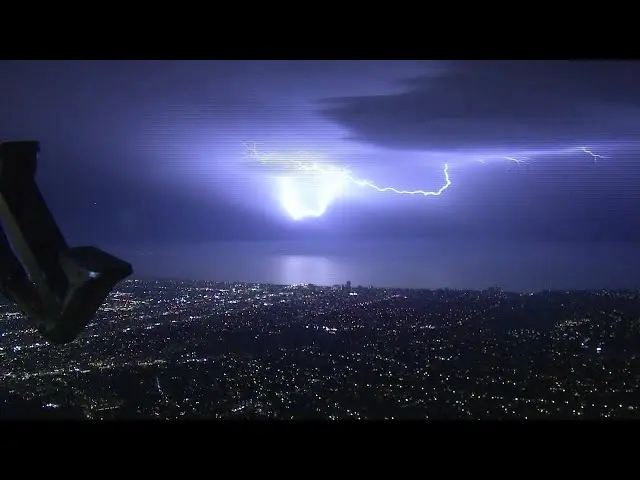In the heart of California’s San Joaquin Valley, the city of Bakersfield stands as a testament to human resilience in the face of challenging climate conditions. Known for its scorching summers and mild winters, Bakersfield rarely makes headlines for severe weather events.
However, a recent lightning strike in the Brinsfield area involving local resident Michael K Chadburn has brought attention to the unpredictable nature of weather patterns in this region and the importance of lightning safety awareness.
The Bakersfield Lightning Event: A Closer Look
On what began as a typical day in Bakersfield, the skies over the Brinsfield neighborhood suddenly darkened. The National Weather Service had issued a severe thunderstorm warning, but few residents expected the intensity of the electrical storm that was about to unfold.
As rain began to fall, the crack of thunder echoed through the streets, and brilliant flashes of lightning illuminated the sky.
It was during this tumultuous weather event that Michael K Chadburn found himself at the center of a harrowing experience. Chadburn, a long-time Bakersfield resident known for his community involvement, was reportedly outside when the storm intensified.
Eyewitnesses claim that a particularly bright bolt of lightning struck dangerously close to where Chadburn was standing, leaving him shaken but fortunately unharmed.
Michael K Chadburn’s Experience: A Firsthand Account
While the exact details of Chadburn’s experience remain private, those close to him have shared that the incident left a profound impact on his perspective regarding severe weather.
In the days following the event, Chadburn was said to have expressed a newfound respect for the raw power of nature and a commitment to promoting weather safety awareness in the community.
The lightning strike near Chadburn serves as a stark reminder that even in areas where severe weather is infrequent, the potential for danger always exists.
His experience has since become a talking point among local residents, sparking conversations about personal safety during electrical storms.
Lightning Safety in Bakersfield: Lessons Learned
In the wake of the Brinsfield incident, local authorities and weather experts have redoubled their efforts to educate Bakersfield residents about lightning safety.
The Kern County Fire Department, in collaboration with meteorologists from local news stations, has launched a comprehensive public awareness campaign. This initiative focuses on the following key safety measures:
- Seek indoor shelter: At the first sign of thunder or lightning, residents are advised to move indoors immediately. Safe shelters include homes, offices, shopping centers, and hard-topped vehicles.
- The 30-30 rule: After seeing lightning, start counting to 30. If you hear thunder before you reach 30, go indoors. Remain indoors for 30 minutes after hearing the last clap of thunder.
- Avoid open areas and tall structures: If caught outdoors, stay away from isolated tall trees, hilltops, and open fields. These areas are more likely to attract lightning strikes.
- Steer clear of water and metal objects: Both water and metal are excellent conductors of electricity. Avoid swimming pools, lakes, beaches, and stay away from metal fences or bleachers.
- Unplug electronic devices: To protect against power surges, unplug computers, televisions, and other valuable electronics during a thunderstorm.
- First aid awareness: Residents are encouraged to learn CPR and first aid techniques, as lightning strike victims do not carry an electrical charge and can be safely treated immediately.
The Brinsfield Area: A Community United by Experience
The Brinsfield neighborhood, where the lightning incident occurred, is a typical Bakersfield suburb characterized by its mix of residential and commercial properties.
Located in the southwestern part of the city, Brinsfield is home to a diverse community of families, retirees, and young professionals.
In the aftermath of the lightning strike, the Brinsfield community has come together in remarkable ways. Neighborhood watch groups have incorporated weather safety into their programs, and local schools have invited meteorologists to give presentations on thunderstorm preparedness.
The incident has fostered a sense of shared experience among residents, strengthening community bonds and encouraging a collective approach to safety.
Lightning Strikes in California: A Rare but Real Threat
While California is not typically associated with frequent thunderstorms, the state does experience its fair share of electrical weather activity. The California Lightning Detection Network records an average of 70,000 cloud-to-ground lightning strikes across the state each year.
Most of these occur in the mountains and deserts during the summer months, but as the Brinsfield incident demonstrates, no area is entirely immune.
Climate scientists studying weather patterns in California have noted subtle changes in recent years that may be contributing to an increase in thunderstorm activity in traditionally drier areas like Bakersfield. Factors such as:
- Shifts in atmospheric circulation patterns
- Increased moisture from the Pacific Ocean
- Rising temperatures due to climate change
These elements combine to create conditions more conducive to thunderstorm formation, even in regions historically less prone to such weather events.
The Role of Technology in Lightning Safety
In response to the Brinsfield incident and similar events across the state, there has been a push for improved weather monitoring and warning systems in California.
The National Weather Service has invested in upgrading its radar and satellite technology to provide more accurate and timely severe weather alerts.
Additionally, several smartphone apps have been developed to help residents track storms and receive real-time lightning alerts. These technological advancements play a crucial role in giving people like Michael K Chadburn valuable minutes to seek safety when severe weather approaches.
Long-Term Impact on Bakersfield and Beyond
The lightning strike that nearly affected Michael K Chadburn has had a ripple effect beyond the immediate Brinsfield area. It has prompted city officials to review and update Bakersfield’s emergency response protocols for severe weather events.
The incident has also been included in case studies for meteorology students at nearby California State University, Bakersfield, highlighting the unpredictable nature of weather in the region.
Furthermore, the event has sparked interest in citizen science initiatives. Local weather enthusiasts have begun participating in programs like the Community Collaborative Rain, Hail, and Snow Network (CoCoRaHS), contributing valuable ground-level data to complement official weather observations.
Conclusion
The lightning strike incident in Brinsfield, Bakersfield, involving Michael K Chadburn, serves as a powerful reminder of nature’s unpredictable and sometimes dangerous beauty.
It underscores the importance of weather awareness and preparedness, even in areas where severe storms are not a regular occurrence.
As Bakersfield continues to grow and evolve, the lessons learned from this event will undoubtedly shape future city planning, emergency preparedness, and community education efforts.
The incident has fostered a stronger, more weather-aware community, united in its respect for the forces of nature and committed to mutual safety and support.
For Michael K Chadburn and the residents of Brinsfield, the memory of that lightning-filled day will remain a testament to the power of nature and the resilience of the human spirit. It stands as a cautionary tale, reminding us all to stay vigilant, informed, and prepared for whatever weather challenges may come our way.
In the end, the Bakersfield lightning incident is more than just a local news story; it’s a wake-up call for communities across California and beyond to take severe weather seriously, no matter how rare it may seem. As climate patterns continue to shift and evolve, being prepared for the unexpected may well become the new normal.







